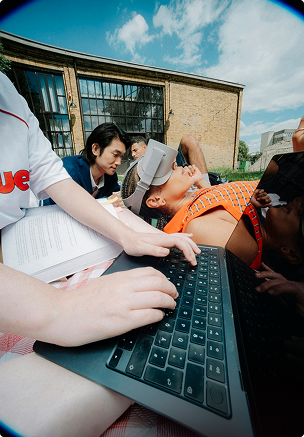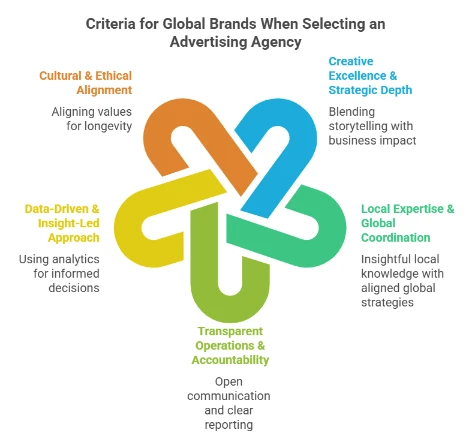






















If you’re leading marketing for a global brand, you already know the pressure that comes with scale. Every campaign has to land across markets, stay culturally relevant, and still sound unmistakably like you.
That’s why choosing an advertising agency is a strategic decision. The agency you select will define how your brand performs across markets, how your message adapts across cultures, and how fast you can move when things shift.
At this level, coordination is just as important as creativity. Also, the competition is only getting tighter.
As reported by WPP Media, global ad revenue is expected to reach $1.08 trillion by the end of 2025, with 6.1% growth projected for 2026. That growth means one thing: more brands fighting for the same attention.
So, let’s break down how to choose an advertising agency built for that reality. Because the right partner can bring structure to scale, clarity to every market you reach and, more importantly, leverage over your competitors.
Let’s begin, shall we?
If you only have a minute, here’s what to remember:
Global brands like yours operate in tension: stay consistent, stay relevant, and stay fast. Each market adds new layers: different cultures, consumer expectations, and local regulations.
From our experience, global success starts with clarity. When leadership agrees on the core goal (growth, brand equity, or market expansion), every other decision gains direction.
That alignment drives how you set goals, define scope, and protect your brand identity across markets.
Here’s what that looks like:
Every global campaign starts with alignment between business strategy and marketing intent. Your marketing goals only work if they map directly to outcomes, be it revenue growth, stronger brand equity, or lead generation in priority regions.
Otherwise, you’ll be 67% less effective at closing deals.
Unfortunately, we’ve seen too many teams approach agencies with ambition but no definition. That’s where projects drift. A capable agency won’t just accept a broad vision; they’ll push you to sharpen it.
When objectives are specific and measurable, every other part (budget, creative direction, and performance tracking) has a solid foundation.
Scope determines structure. It’s what turns ideas into execution.
Decide early how you’ll manage control. Will you centralize creative and media under one lead global agency? Or build a network of regional partners guided by a shared framework?
There’s no universal model: it depends on how your teams operate and where you need autonomy.
So, define your scope of work clearly: campaign management, media planning, creative direction, or integrated digital strategy. A precise brief makes evaluation objective and pricing transparent.
Consistency isn’t about sameness. Actually, it is the purpose that matters.
Your message, tone, and design should adapt to the local context while preserving meaning. Leading brands like Apple, Airbnb, and Unilever pull this off by pairing strict brand guidelines with flexibility in local execution.
A strong global agency knows when to protect the core and when to adapt. They use research and analytics to steer decisions with precision instead of instinct.
That’s how brands stay unified worldwide yet feel genuinely local in every market.
P.S.: The best global brands adapt without diluting their identity. Dive into our guide on how to localize creative without losing brand codes; it’s a playbook for balance at scale.
Finding the right agency takes more than reviewing pitch decks. You’re looking for a team that understands your business model, your markets, and your speed of execution.
From our experience, the right process filters out agencies that look good on paper but can’t perform under real pressure.
Here’s how to approach it, step by step:
.webp)
Every global campaign needs a north star. What does success look like? More market share, stronger brand equity, or faster lead generation?
Your agency should be able to connect creative direction to those outcomes.
If they can’t, that’s your first red flag. Global goals need to be specific enough to guide budgets, timelines, and performance tracking.
Pro tip: We’ve seen brands lose months because internal teams weren’t aligned before inviting agencies to pitch. So, get your leadership on the same page first, then the rest of the process flows smoothly.
Some brands rely on one lead agency to handle both, while others combine a global hub with local creative teams to stay agile. What matters is finding the balance between centralized control and regional flexibility.
Next, define your service needs: creative, media, digital, or full-service. The clearer your scope of work, the easier it becomes to benchmark pricing, timelines, and performance.
At Fieldtrip, for example, we help brands define scope with precision before they start meeting agencies. Our process focuses on building frameworks that scale: clear enough to compare partners, strong enough to drive decisions that hold up globally.
If your agency isn’t fluent in programmatic buys, social data, or cross-channel attribution, they’re already lagging.
Now comes the filtering process. Start with reputation and reach, but go deeper. Review case studies that match your industry and campaign size.
Real performance tells a different story from a polished pitch deck. In a survey by Brainz Magazine, 41% of brands said an agency’s past work was a key factor in their final decision.
Pro tip: We’d argue it’s not just what they’ve done, but how they did it and what results they got.
Did their campaigns drive measurable growth? Did they adapt their strategy by market? Did they maintain brand identity while scaling creative output?
With that in mind, look for agencies that can show range. In other words, enterprise-level agency partners that deliver both vision and operational rigor.
Creativity without strategy is noise. Likewise, a strategy without creativity is forgettable. The right agency masters both.
In this step, assess how they translate ideas into results. Ask how they handle market research, testing, and creative validation. A great agency can back its concepts with clear evidence.
For example, at Fieldtrip, we can prove this with the NielsenIQ case study: a global campaign that ran in 20+ languages and 17 countries, using UGC to drive recruitment at scale.
With 100 creators active each month across five digital channels, we kept creativity rooted in culture while maintaining a unified brand story. That’s adaptability that performs.

Digital maturity is equally non-negotiable.
With 73% of global ad revenue tied to digital in 2025 (as reported by the WPP report above), weak tech integration is a dealbreaker.
Add to that the finding from Brainz Magazine’s survey that 79% of brands are willing to pay more for agencies with expertise in their industry. Specialization is something we see more and more brands looking for.
If an agency can’t articulate how they’d scale your creative across media channels or adapt it to multiple target demographics, keep searching.
P.S.: Testing is how great ideas go global. See how large brands refine creative with precision in our creative testing and measurement guide.
You can’t fake chemistry. A great agency partnership works because both sides communicate clearly and move at the same pace.
At this point, pay attention to responsiveness, transparency, and how senior leadership shows up in early meetings.
We’ve seen mismatched partnerships implode simply because one side worked at a sprint and the other moved like an audit committee. That gap in tempo kills results.
You’ll want an agency that mirrors your internal rhythm, decisive, transparent, and execution-driven.
At Fieldtrip, we work in tight, autonomous teams aligned by a single strategic backbone. That setup keeps us focused, fast, and capable of scaling complex global work without losing clarity. Learn more about our MO here.
Right now, data is the backbone of performance marketing.
That’s why you should ask about their analytics tools, dashboards, and attribution models. The best agencies integrate data from every channel to make real-time optimizations.
Also, don’t skip the tech question. According to benchmarks, 77% of agencies now use AI in their workflows… but are they using it correctly and to your advantage?
If a team can’t explain how automation supports efficiency or insight, that’s a red flag. The absence of AI usually signals an outdated stack, or worse, a lack of process discipline.
Before you sign with any advertising agency, test the partnership.
Run a pilot project or a short workshop. It’s the fastest way to see how both teams think, execute, and communicate under real-world conditions.
As reported by Brainz Magazine, 76% of brands say social proof influences their vetting process, and 80% consult at least two other agencies before deciding. That tells you something: chemistry and credibility go hand in hand.
A strong agency doesn’t need to oversell. Instead, they let the collaboration speak for itself.
P.S.: Are you an agency looking for more clients and running multiple pitch rounds yourself? Check our guide on how to run a successful agency pitch process for large organizations.
Choosing a global advertising agency isn’t about who gives the best pitch deck. The real test is if they can scale creativity and discipline across borders.
The next criterion will tell you who’s built for that level of execution and who’s not:

Your agency should bring more than creative ideas. They should bring strategic insight.
So, look for teams that connect global storytelling with business logic. The best agencies can pivot between bold creative work and performance-driven messaging without losing consistency.
They’ll show you campaigns that don’t just look good but move numbers and explain why.
P.S.: Bold ideas are easy, but global impact isn’t. Don’t miss out on our shortlist of the best creative agencies for global brands; the ones that make creativity work everywhere.
The biggest weakness we see in global partnerships? Great ideas that get lost in translation.
Your agency should have genuine local market expertise (people who know the culture, language, and consumer mindset) and a global process that ties it all together.
For example, for NielsenIQ, we cut CPA by 37% through performance creative creators across 19 countries, using hyper-localized strategies.
Here’s one example for Germany, where you can notice the family angle:
By comparison, singles 65+ was a good niche in the UK:
This kind of research and segmentation is what separates scalable campaigns from disjointed ones. Of course, you need a solid system that keeps every regional launch aligned without stifling local creativity.
Transparency builds trust, and trust drives retention. 36% of agencies say transparency is the single most important factor in keeping clients, yet very few deliver on it consistently.
That’s why it’s worth testing this early. Ask to see their reporting frameworks, escalation paths, and leadership access. You’ll learn quickly how open (or how guarded) they really are.
A good global agency runs on instinct. A great one runs on data-backed instinct.
They should be using predictive analytics, real-time dashboards, and cross-channel tracking to guide your strategy. And of course, they need the right tools for that.
If they can’t show how insights fuel creative or media decisions, they’re operating on assumptions.
The agencies that win are the ones that know what to do with data.
Every long-term partnership depends on shared values.
Ask how the agency approaches diversity, sustainability, and brand representation. You’ll quickly see if their ethics align with yours.
And yes, this matters commercially too. Cultural alignment impacts creative resonance and brand safety in every market you operate in.
Most brands don’t fail because they pick a bad agency. In reality, they fail because they choose for the wrong reasons.
Here’s what we see most often, and what to stay away from:
These are simple mistakes that compound fast. The fix is equally simple: choose with clarity, not with urgency.
Selecting a global advertising agency is equal parts strategy and chemistry. You need structure to stay objective, but instinct still matters.
The shortlist stage is where you balance both:
A solid RFP gives direction; everything else is just documentation.
So, outline your objectives, scope, KPIs, and timelines clearly. Then share just enough context for agencies to show their thinking.
Pro tip: The best RFPs read like conversations. They help you see how each team approaches your brand’s challenges.
When reviewing proposals, evaluate clarity over creativity. A team that can simplify complex tasks will likely handle global execution with the same precision. And if an agency’s answers feel vague or templated, that’s your cue they’re not ready for enterprise-level work.
P.S.: Save time with this enterprise marketing RFP template; it covers structure, scoring, and criteria for global partnerships.
Chemistry meetings are underrated. They show how your teams collaborate before the contract is signed.
Use them to test how agencies think under pressure. Then, bring up a real problem (an underperforming campaign, a messy reporting process) and watch how they respond. Do they challenge you with questions or default to jargon?
If you’re still unsure, run a small-scale pilot. A focused project is the fastest way to validate fit. You’ll see their process, speed, and problem-solving firsthand.
The takeaway here: chemistry and performance should align. One without the other never lasts.
Beyond executing briefs, a capable advertising agency expands what your brand can do. It also helps you push into new markets, move faster, and build an edge your competitors can’t copy.
From what we’ve seen, the best partnerships come from alignment. When your agency understands your strategy, tempo, and brand DNA, global execution becomes seamless.
Treat the selection process like a long-term investment. The right agency will challenge your assumptions, protect your brand consistency, and find growth opportunities you didn’t see coming.
At Fieldtrip, we believe strong partnerships build stronger brands. If you’re looking for an agency that understands global scale without losing focus on what makes you unique, let’s talk.
Start with your goals. Define what you want to achieve globally (brand awareness, market expansion, or revenue growth), then find agencies with a track record in those areas. Review case studies, talk to references, and test collaboration before you commit.
A strong agency will also show how its work connects across channels, from social media to search engines.
Look for clarity, capability, and chemistry. The right partner should connect creative ideas to measurable outcomes and communicate transparently throughout the process.
If they can’t explain how they measure success, that’s a red flag. Bonus points if they can show how content creation and content marketing tie directly to campaign results.
They combine scale with nuance. Great agencies can manage global strategy while localizing creative for each market. They’re strong in digital advertising, disciplined in reporting, and consistent in execution.
The best ones also drive long-term brand development through data-backed storytelling.
Watch how they listen. Cultural fit shows in how teams communicate, challenge ideas, and respect boundaries. Also, meet the actual team that would handle your account, not just leadership.
Through process and data. The best agencies use shared guidelines, centralized tools, and analytics to keep messaging consistent while letting local teams adapt tone and execution.
That balance between structure and flexibility keeps advertising campaigns aligned across every region.
It’s essential. Data drives optimization, reporting, and decision-making. Ask how they use analytics tools, what metrics they track, and how they connect performance data to creative strategy.
Agencies fluent in Search Engine Optimization and multi-channel attribution typically have a stronger read on ROI.
You’ll feel it in the results. Declining performance, lack of transparency, or inconsistent communication are warning signs. If your agency isn’t evolving with your business or adapting to areas like web development or web design, it’s time to move on.